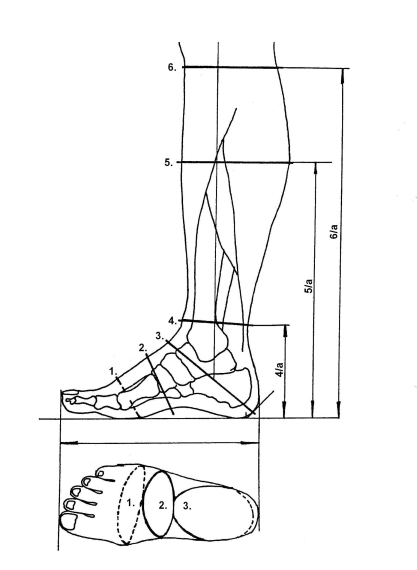Process
Stand on the order form, and the measurement taker draws around both feet with a pencil, keeping it slightly towards the feet, in almost 90° angle. On the drawing you always have to mark the inner and outer joint, the extraordinary, deformed parts like hammer toe, joint, painful callus, etc.. To measure the length and fullness, we always use shoemaker tape-measure, following the profile of the feet. Don't pull the measuring tape too tight, but it cannot be loose either. When you are finished, please scan your feet drawing & measurements in pdf and send it to us in e-mail!
Important!
- You have to take measurements always in standing position, so when the foot are stressed.
- Please provide us the sizes in centimeters (cm).
- Always send us your normal shoe size too. It's very informative for us, because we'll know based on your measurements, that you prefer loose, or exactly fitting shoes on your feet.
- Please always send also at least 3 photos of the feet (from top, side, and back)!
- If your feet had a surgery, have ortopedic problems or swells often, notify us.
Tips:
- The best time to measure the feet is the afternoon, because feet size changes during the day.
- Always wear socks while measuring, because you will wear the shoes with them. If your shoes will be winter shoes/boots, you should wear thick socks when measuring. It can count a lot.
- Ask for the help of a second person for measuring, because taking your own measurements correctly is pretty difficult.
- The feet have to be measured in every 2 years, because they change over time. If you loose or put on more than 10 kg weight, remeasuring is recommended also.
For perfect fit we can send you measuring foam for extra cost.
The most important measurements for every shoes:
1. Joint fullness: the perimeter measured through the top points of inner and outer joint. This measurement It is not always perpendicular to the longitudinal axis of the feet, but can be inclined a little bit. Please be sure that you measure on the top of outer joint, not before it, not between your little toe and joint.
2. Instep fullness: the perimeter measured through the highest point of feet arch and the top of the instep curve.
3. Heel fullness: the perimeter measured through the middle of the heel and the highest point of instep-curve
+1 Feet length: The longest straight line, that connects the heel and usually the big toe, or second toe. It's important for us, because in case of printing your foot drawing, helps us to keep aspect ratio.
Please mark on the foot drawing, that where have you measured the above mentioned fullnesses.
Measurements needed only for boots and legged shoes
4. Ankle fullness: it's measured right above the ankle, it's the shortest perimeter of the lower leg.
4a. Ankle height: the height measured from the floor till the level of ankle.
6. Leg fullness: This time, we measure the fullness in the height, what you desire.
6a. Leg height: The height from to floor, till the height, which the customer ordered.
Measurements needed only for legged shoes
5. Calf fullness: the longest perimeter of lower leg (below knee), which is measured through the highest point of calf.
5/a. Calf height: the height measured from the floor till the widest, fullest level of the calf.
 Hungarian (HU)
Hungarian (HU)  English (UK/US)
English (UK/US) 


